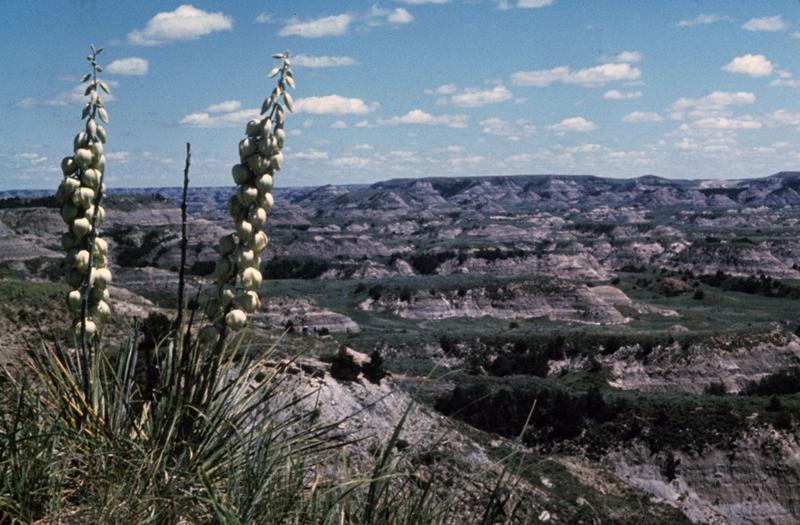Hupȟéstola, aka Soapweed or Yucca, is a common sight in western North Dakota. Theodore Roosevelt National Park.
Light And Warmth Like The SunThe First Fire
By Óta
Kté (Kills Many), Luther Standing Bear
GREAT PLAINS - Luther
Standing Bear was an Oglála Lakȟóta.
He attended the Carlisle Indian School in Pennsylvania, worked in Buffalo
Bill’s Wild West show, appeared in twelve motion pictures, and authored six
books. “The First Fire,” appears in Standing Bear’s “Stories of The Sioux,” published
in 1938.
A Sioux[1]
scout, tired and weary from a long journey, sat down on the plain to rest.
Beside him lay a fallen yucca[2]
plant with its long body stretched upon the ground. The scout aimlessly picked
up a small stick that lay nearby, and, rubbing it between his hands upon the
yucca, noticed a thin blue vapor arising.[3]
This vapor smelled very pleasant as it rose in the
air and disappeared. The scout thought that, since it went up and out of sight,
it must go to the land of the Sky People. And going up so far it would, no
doubt, carry a message to those who lived in the sky.
So the scout played on, enjoying the blue clouds of
smoke as they ascended and disappeared in the air. After a while a small red
and orange flame[4] burst from the tip of the
stick. It was beautiful, and the heat that came with it was very agreeable.
Interested now beyond all care to continue his journey, the scout watched the
stick and yucca plant change into this lovely flame that sprang up, looking
like a beautiful plume, only to fade away and form into another just as
beautiful. How strange and yet how beautiful it is, thought the scout. He never
wanted to lose this beautiful being, whatever it was.
So he fed the flame with more yucca, and it lived
and grew. He could not leave it here to perish, and yet he was forced to go
home at last. So he carried a burning wand back to the village with him, and in
the center, where all could see, he made it grow with more yucca. All the
people of the village came and sat about, marveling at the wonder of it all.
"Lakota Oglala Campfire" by Hubert Wackerman.
This gorgeous red flame was warming to the hands
and body, but could hurt severely if one got too close. It looked soft and
caressing, but stung the fingers if one tried to catch and hold the lovely curling
feathers of fire. The wood which was put in these flames to keep them alive
turned into brilliant red coals that sparkled and changed color too. So all day
the village people watched, and when evening came they were still gathered
there. This marvel was something like the sun, for it lighted up the space in
which they sat. Strange it did not do this in daytime. Only at night. This
fascinating being had wondrous ways hard to understand.
Since the beautiful flame burned one’s hand and
toes, what would it do to meat? A piece of buffalo meat was held close, and as
the flame wound about it the odor was strangely tempting. The meat was tasted,
and it was good. Everyone tasted the meat that came from the red hot coals, and
all found it delicious. No longer would the Sioux prepare their meat only by
the heat of the sun.[5]
And so this is the way fire was brought to the
Sioux people. The man who brought it to them is great in their history.
Note: The introduction of fire brought cultural changes, such as the fire-starting, or carrying the fire - which involved carrying a live coal, perhaps from a council fire, and bringing it to the next campsite, to using fire to hunt with as in driving game, and even communicating as with smoke signals.
[1] Očhetí Šakówiŋ, the Seven Council
Fires, is how the “Sioux” refer to themselves.
[2] Hupȟéstola, also
known as soapweed or yucca. The roots of the plant are harvested, peeled, and
pounded. The soapweed powder can then be mixed with water and produces suds
which one can wash one’s hair.
[3] Paíle, is to ignite or burn as with
friction.
[4] Pȟéta,
fire or flame. Čhethí, is also fire, but a fire built for a purpose (i.e. Očhetí,
as in Očhetí Šakówiŋ, the Seven Council Fires).
[5] The Lakȟóta have several
words to describe cooking by fire: Pasnúŋ, to roast something on a spit; Wačhók’iŋ:
to cook by roasting in the coals; Ğağáya: to roast something over an open
fire as with meat on a stick; etc.



No comments:
Post a Comment